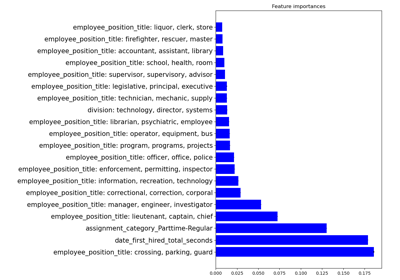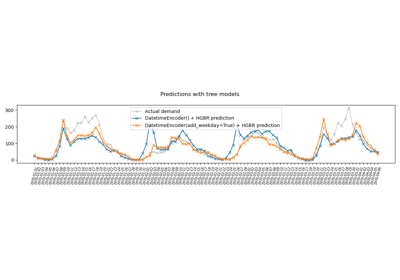skrub.DatetimeEncoder#
Usage examples at the bottom of this page.
- class skrub.DatetimeEncoder(resolution='hour', add_weekday=False, add_total_seconds=True)[source]#
Extract temporal features such as month, day of the week, … from a datetime column.
Note
DatetimeEncoderis a type of single-column transformer. Unlike most scikit-learn estimators, itsfit,transformandfit_transformmethods expect a single column (a pandas or polars Series) rather than a full dataframe. To apply this transformer to one or more columns in a dataframe, use it as a parameter in askrub.TableVectorizerorsklearn.compose.ColumnTransformer. In theColumnTransformer, pass a single column:make_column_transformer((DatetimeEncoder(), 'col_name_1'), (DatetimeEncoder(), 'col_name_2'))instead ofmake_column_transformer((DatetimeEncoder(), ['col_name_1', 'col_name_2'])).All extracted features are provided as float32 columns.
No timezone conversion is performed: if the input column is timezone aware, the extracted features will be in the column’s timezone.
An input column that does not have a Date or Datetime dtype will be rejected by raising a
RejectColumnexception. SeeToDatetimefor converting strings to proper datetimes. Note: theTableVectorizeronly sends datetime columns to itsdatetime_encoder. Therefore it is always safe to use aDatetimeEncoderas theTableVectorizer’sdatetime_encoderparameter.- Parameters:
- resolution
strorNone, default=”hour” If a string, extract up to this resolution. Must be “year”, “month”, “day”, “hour”, “minute”, “second”, “microsecond”, or “nanosecond”. For example,
resolution="day"generates the features “year”, “month”, and “day” only. If the input column contains dates with no time information, time features (“hour”, “minute”, … ) are never extracted. IfNone, the features listed above are not extracted (but day of the week and total seconds may still be extracted, see below).- add_weekday
bool, default=False Extract the day of the week as a numerical feature from 1 (Monday) to 7 (Sunday).
- add_total_seconds
bool, default=True Add the total number of seconds since the Unix epoch (00:00:00 UTC on 1 January 1970).
- resolution
See also
ToDatetimeConvert strings to datetimes.
Examples
>>> import pandas as pd
>>> login = pd.to_datetime( ... pd.Series( ... ["2024-05-13T12:05:36", None, "2024-05-15T13:46:02"], name="login") ... ) >>> login 0 2024-05-13 12:05:36 1 NaT 2 2024-05-15 13:46:02 Name: login, dtype: datetime64[ns] >>> from skrub import DatetimeEncoder
>>> DatetimeEncoder().fit_transform(login) login_year login_month login_day login_hour login_total_seconds 0 2024.0 5.0 13.0 12.0 1.715602e+09 1 NaN NaN NaN NaN NaN 2 2024.0 5.0 15.0 13.0 1.715781e+09
We can ask for a finer resolution:
>>> DatetimeEncoder(resolution='second', add_total_seconds=False).fit_transform( ... login ... ) login_year login_month login_day login_hour login_minute login_second 0 2024.0 5.0 13.0 12.0 5.0 36.0 1 NaN NaN NaN NaN NaN NaN 2 2024.0 5.0 15.0 13.0 46.0 2.0
We can also ask for the day of the week. The week starts at 1 on Monday and ends at 7 on Sunday. This is consistent with the ISO week date system (https://en.wikipedia.org/wiki/ISO_week_date), the standard library
datetime.isoweekday()and polarsweekday, but not with pandasday_of_week, which counts days from 0.>>> login.dt.strftime('%A = %w') 0 Monday = 1 1 NaN 2 Wednesday = 3 Name: login, dtype: object >>> login.dt.day_of_week 0 0.0 1 NaN 2 2.0 Name: login, dtype: float64 >>> DatetimeEncoder(add_weekday=True, add_total_seconds=False).fit_transform(login) login_year login_month login_day login_hour login_weekday 0 2024.0 5.0 13.0 12.0 1.0 1 NaN NaN NaN NaN NaN 2 2024.0 5.0 15.0 13.0 3.0
When a column contains only dates without time information, the time features are discarded, regardless of
resolution.>>> birthday = pd.to_datetime( ... pd.Series(['2024-04-14', '2024-05-15'], name='birthday') ... ) >>> encoder = DatetimeEncoder(resolution='second') >>> encoder.fit_transform(birthday) birthday_year birthday_month birthday_day birthday_total_seconds 0 2024.0 4.0 14.0 1.713053e+09 1 2024.0 5.0 15.0 1.715731e+09 >>> encoder.extracted_features_ ['year', 'month', 'day', 'total_seconds']
(The number of seconds since Epoch can still be extracted but not “hour”, “minute”, etc.)
Non-datetime columns are rejected by raising a
RejectColumnexception.>>> s = pd.Series(['2024-04-14', '2024-05-15'], name='birthday') >>> s 0 2024-04-14 1 2024-05-15 Name: birthday, dtype: object >>> DatetimeEncoder().fit_transform(s) Traceback (most recent call last): ... skrub._on_each_column.RejectColumn: Column 'birthday' does not have Date or Datetime dtype.
ToDatetime: can be used for converting strings to datetimes.>>> from skrub import ToDatetime >>> from sklearn.pipeline import make_pipeline >>> make_pipeline(ToDatetime(), DatetimeEncoder()).fit_transform(s) birthday_year birthday_month birthday_day birthday_total_seconds 0 2024.0 4.0 14.0 1.713053e+09 1 2024.0 5.0 15.0 1.715731e+09
Time zones
If the input column has a time zone, the extracted features are in this timezone.
>>> login = pd.to_datetime( ... pd.Series( ... ["2024-05-13T12:05:36", None, "2024-05-15T13:46:02"], name="login") ... ).dt.tz_localize('Europe/Paris') >>> encoder = DatetimeEncoder() >>> encoder.fit_transform(login)['login_hour'] 0 12.0 1 NaN 2 13.0 Name: login_hour, dtype: float32
No special care is taken to convert inputs to
transformto the same time zone as the column the encoder was fitted on. The features are always in the time zone of the input.>>> login_sp = login.dt.tz_convert('America/Sao_Paulo') >>> login_sp 0 2024-05-13 07:05:36-03:00 1 NaT 2 2024-05-15 08:46:02-03:00 Name: login, dtype: datetime64[ns, America/Sao_Paulo] >>> encoder.transform(login_sp)['login_hour'] 0 7.0 1 NaN 2 8.0 Name: login_hour, dtype: float32
To ensure datetime columns are in a consistent timezones, use
ToDatetime.>>> encoder = make_pipeline(ToDatetime(), DatetimeEncoder()) >>> encoder.fit_transform(login)['login_hour'] 0 12.0 1 NaN 2 13.0 Name: login_hour, dtype: float32 >>> encoder.transform(login_sp)['login_hour'] 0 12.0 1 NaN 2 13.0 Name: login_hour, dtype: float32
Here we can see the input to
transformhas been converted back to the timezone used duringfitand that we get the same result for “hour”.- Attributes:
- extracted_features_
listof strings The features that are extracted, a subset of [“year”, …, “nanosecond”, “weekday”, “total_seconds”]
- extracted_features_
Methods
fit(column[, y])Fit the transformer.
fit_transform(column[, y])Fit the encoder and transform a column.
Get metadata routing of this object.
get_params([deep])Get parameters for this estimator.
set_fit_request(*[, column])Request metadata passed to the
fitmethod.set_params(**params)Set the parameters of this estimator.
set_transform_request(*[, column])Request metadata passed to the
transformmethod.transform(column)Transform a column.
- fit(column, y=None)[source]#
Fit the transformer.
Subclasses should implement
fit_transformandtransform.- Parameters:
- columna pandas or polars
Series Unlike most scikit-learn transformers, single-column transformers transform a single column, not a whole dataframe.
- ycolumn or dataframe
Prediction targets.
- columna pandas or polars
- Returns:
- self
The fitted transformer.
- get_metadata_routing()[source]#
Get metadata routing of this object.
Please check User Guide on how the routing mechanism works.
- Returns:
- routingMetadataRequest
A
MetadataRequestencapsulating routing information.
- set_fit_request(*, column='$UNCHANGED$')[source]#
Request metadata passed to the
fitmethod.Note that this method is only relevant if
enable_metadata_routing=True(seesklearn.set_config()). Please see User Guide on how the routing mechanism works.The options for each parameter are:
True: metadata is requested, and passed tofitif provided. The request is ignored if metadata is not provided.False: metadata is not requested and the meta-estimator will not pass it tofit.None: metadata is not requested, and the meta-estimator will raise an error if the user provides it.str: metadata should be passed to the meta-estimator with this given alias instead of the original name.
The default (
sklearn.utils.metadata_routing.UNCHANGED) retains the existing request. This allows you to change the request for some parameters and not others.Added in version 1.3.
Note
This method is only relevant if this estimator is used as a sub-estimator of a meta-estimator, e.g. used inside a
Pipeline. Otherwise it has no effect.
- set_params(**params)[source]#
Set the parameters of this estimator.
The method works on simple estimators as well as on nested objects (such as
Pipeline). The latter have parameters of the form<component>__<parameter>so that it’s possible to update each component of a nested object.- Parameters:
- **params
dict Estimator parameters.
- **params
- Returns:
- selfestimator instance
Estimator instance.
- set_transform_request(*, column='$UNCHANGED$')[source]#
Request metadata passed to the
transformmethod.Note that this method is only relevant if
enable_metadata_routing=True(seesklearn.set_config()). Please see User Guide on how the routing mechanism works.The options for each parameter are:
True: metadata is requested, and passed totransformif provided. The request is ignored if metadata is not provided.False: metadata is not requested and the meta-estimator will not pass it totransform.None: metadata is not requested, and the meta-estimator will raise an error if the user provides it.str: metadata should be passed to the meta-estimator with this given alias instead of the original name.
The default (
sklearn.utils.metadata_routing.UNCHANGED) retains the existing request. This allows you to change the request for some parameters and not others.Added in version 1.3.
Note
This method is only relevant if this estimator is used as a sub-estimator of a meta-estimator, e.g. used inside a
Pipeline. Otherwise it has no effect.
Examples using skrub.DatetimeEncoder#

Encoding: from a dataframe to a numerical matrix for machine learning

Handling datetime features with the DatetimeEncoder
